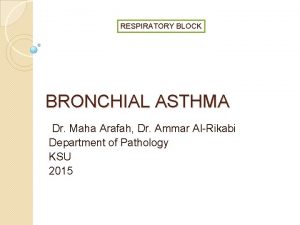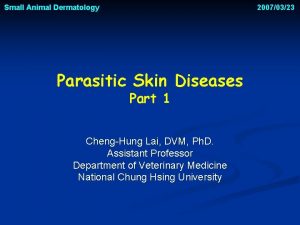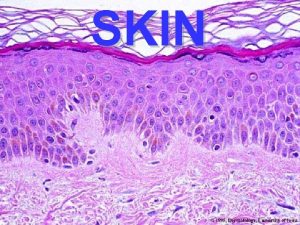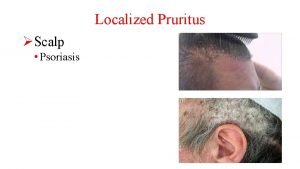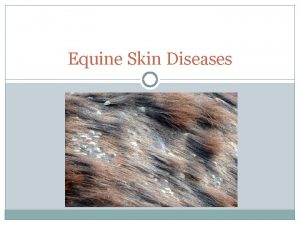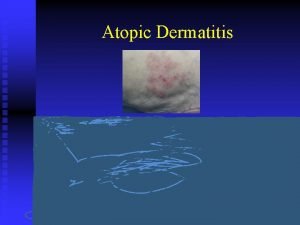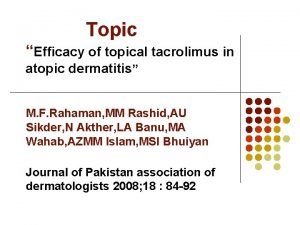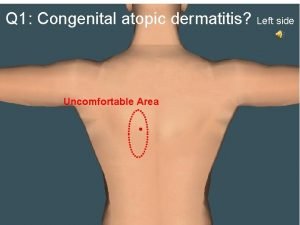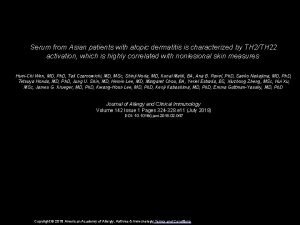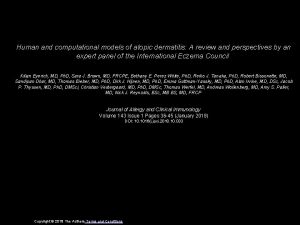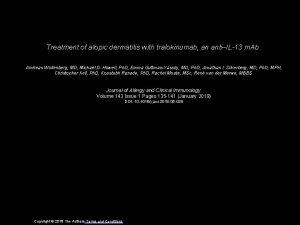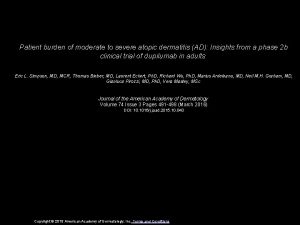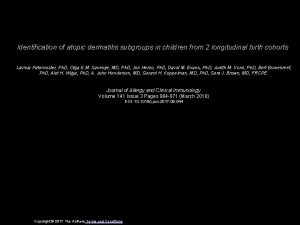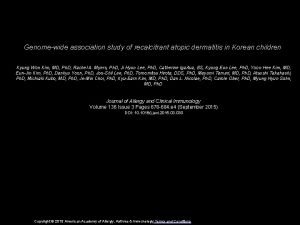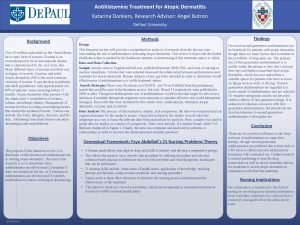Introduction of Canine Atopic Dermatitis Canine atopic dermatitis




















- Slides: 20

Introduction of Canine Atopic Dermatitis

Canine atopic dermatitis (CAD) Definition • Canine atopic dermatitis (CAD) A genetically predisposed inflammatory and pruritic allergic skin disease with characteristic clinical features associated with Ig. E antibodies most commonly directed against environmental allergens • Canine atopic-like dermatitis An inflammatory and pruritic skin disease with clinical features identical to those seen in canine atopic dermatitis in which an Ig. E response to environmental or other allergens cannot be documented

Canine atopic dermatitis (CAD) Canine Atopy I. Pruritic dermatitis II. Chronically recurring inflammatory skin disease III. Type 1 hypersensitivity IV. Specific environmental allergens. Genetic Microbial Environmantal Immunological CAD Pharmacological

Canine atopic dermatitis (CAD) Pathogenesis of Type 1 hypersensitivity

Canine atopic dermatitis (CAD) Threshold phenomenon and summation of effects Initiation of clinical signs Threshold of clinical signs Increased Allergic load [Threshold phenomenon] Threshold of clinical signs Summation of different kinds of allergic load [Summation of effects]

Canine atopic dermatitis (CAD) *Canine atopy VS Food allergy I. Food allergy can mimic CAD I. Some dermatologist include food allergy as a cause of CAD II. Regardless, all dogs suspected of having CAD should be treated, at least in part, with an elimination diet. II. Food management should be treated for CAD

Canine atopic dermatitis (CAD) Clinical signs Pruritus and erythema Otitis externa (most common) (about 80% of cases) Pyoderma Periocular alopecia lichenification and mild crusting (secondary infection)

Canine atopic dermatitis (CAD) Diagnosis – Rule out other cause 1 st Parasite infestation • Scabies • Cheyletiellosis, • Pediculosis • Demodex 2 nd Microorganism infection • Staphylococcus spp. • Dermatophytosis • Malassezia Rule out the all cause above CAD 3 rd Other hypersensitivity • Food allergy • Contact dermatitis • Flea bite

Canine atopic dermatitis (CAD) Diagnosis of CAD: 3~4 of major criteria with minor criteria support Major criteria Minor criteria • Age of onset: between 1~3 years • Bilateral conjunctivitis (range: 6 months ~3 years) • Facial erythema and cheilitis • Glucocorticoid responsive pruritus • Recurrent staphylococcal pyoderma • Typical distribution of pruritus and • Seasonal or non-seasonal intermittent lesions (facial, pedal, ventral and may exacerbations involve perianal area) • Positive intradermal allergy test or • Otitis externa or bilateral erythema elevated allergen specific serum Ig. E of the concave aspects of the pinna levels. • Chronic or chronically relapsing • Genetically predisposed breed.

Canine atopic dermatitis (CAD) Diagnosis – Intradermal allergy test (IDAT) ØSubjective interpretation ØDifficult test procedure This intradermal allergy test (IDAT) demonstrates positive reactions with classic erythematous, well-demarcated, raised reactions. Note the difference between negative and positive reactions.

Canine atopic dermatitis (CAD) Diagnosis of CAD -Rule out of causes -Criteria based diagnosis -Intradermal skin test difficult to test in local clinic -Ig. E measurement specific allergen in lab extreme cost

Canine atopic dermatitis (CAD) Anigen Rapid Total Ig. E Rapid Test I. III. Easy test procedure Objective result interpretation Semi-quantify total Ig. E

Canine atopic dermatitis (CAD) Difference between total Ig. E and allergen specific Ig. E Anigen total Ig. E test Allergen specific Ig. E test üMeasure summation effect of allergic load üIg. E semi-quantify against allergen üSuitable for 1 st action to support CAD diagnosis üMore easy test procedure is available in animal clinic Threshold of clinical signs Allergen specific Ig. E test üIg. E titeration against each specific antigen üSummation effect is not considered üSuitable for find out the cause of CAD in laboratory Summation of different kinds of allergic load [Summation of effects]

Application of Total Ig. E Kit 1 st Parasite infestation • Scabies • Cheyletiellosis, • Pediculosis • Demodex 2 nd Microorganism infection • Staphylococcus spp. • Dermatophytosis • Malassezia Rule out or treatment of parasite and microorganism cause 3 rd Other hypersensitivity • Food allergy • Contact dermatitis • Flea bite & CAD SUSPECTED? Then…… Elimination diet + Total Ig. E kit Good response + Negative to low total Ig. E result Food allergy No response + Positive to high total Ig. E result Canine Atopy

Treatment of CAD Secondary & Related infection control Specific therapy Symptomatic therapy • Microorganism infection • Parasite infestation • Food allergy • Pyoderma • Otitis externa • Elimination of specific allergen • Allergen specific immunotherapy(ASIT) • Steroids (Glucocorticoids) • Topical NSAID • Antihistamie • EFA (essential fatty acids) • Cyclosporin

Conclusion Replace expensive laboratory method - Rule out causes and Criteria based + Total Ig. E Kit Total Ig. E kit Diagnosis of CAD -Rule out of causes -Alternative method of specific Ig. E -Criteria based diagnosis test -Intradermal skin test difficult -Identify immune status with to test in local clinic reasonable cost -Ig. E measurement specific -Simple test - available in animal allergen in lab extreme cost clinic -Quick result

Application § Rapid Canine Total Ig. E Test Kit – Semiquantitative – Detects serum total Ig. E level higher than 10 ug/ml § Debate about the correlation between Ig. E and allergic diseases (atopic dermatitis or food allergy) Interpretation on the result of the test kit is totally dependent on the veterinarian performing the test.

Application § There is a study on the relationship between total Ig. E and intradermal skin test results and they confirmed that the Ig. E screening test was reliable in case of screening test for mites. Journal of Veterinary Science Vol. 18, No. 2 (2015), 351 -356 § 'Atopic dogs were more likely to have greater concentrations of antibodies to food antigens than dogs of the other groups. This may reflect a non-specific upregulation of Ig. E antibody production to a variety of antigens with no clinical significance. Veterinary Immunology and Immunopathology 92 (2003) 113~124

Cortisone effect on Total Ig. E § Cortisone is one of the main hormones released by the adrenal gland in response to stress which is closely related to cortisol. Therefore, as an immune suppressant. § There were many studies on effect of cortisone on immune system. Seven daily IM injections of cortisone acetate(25 mg/Kg b. w. ) given to rats and rabbits produced a pronounced reduction in the numbers of small lymphocytes in thymus-independent areas, atrophy of the thymic cortex, atrophy of germinal centres and a consequent depressed production of germinal centre-derived cells. Virchows Arch B Cell Pathol Incl Mol Pathol. 1983; 43(1): 43 -54. § In conclusion, the cortisone administration prior to the detection of total Ig. E might give rise to unaccurate test results. § Q: Holding period for the cortisone before Total Ig. E test? Normally, for IDST(Intradermal skin test), it is recommended that steroids be stopped at least 2~4 weeks prior to testing. I think total Ig. E detection is same as IDST.

Thank You !!
 Atopic dermatitis vs contact dermatitis
Atopic dermatitis vs contact dermatitis Dr. morrissette
Dr. morrissette Differential diagnosis for atopic dermatitis
Differential diagnosis for atopic dermatitis Atopic dermatitis yardstick
Atopic dermatitis yardstick Atopic dermatitis pathophysiology
Atopic dermatitis pathophysiology Bronchial asthma
Bronchial asthma Non atopic asthma
Non atopic asthma Helminth
Helminth Hairdressing dermatitis
Hairdressing dermatitis Gora phc palghar
Gora phc palghar Integumentary
Integumentary Mosby
Mosby Hyperlinear palms meaning
Hyperlinear palms meaning Stasis dermatitis
Stasis dermatitis Dyax fungicide
Dyax fungicide Mild scalp psoriasis pictures
Mild scalp psoriasis pictures Seborrheric dermatitis
Seborrheric dermatitis Horse rain rot
Horse rain rot Dermatitis herpetiforme
Dermatitis herpetiforme Púrpura de schamberg causas
Púrpura de schamberg causas Treatment contact dermatitis
Treatment contact dermatitis





